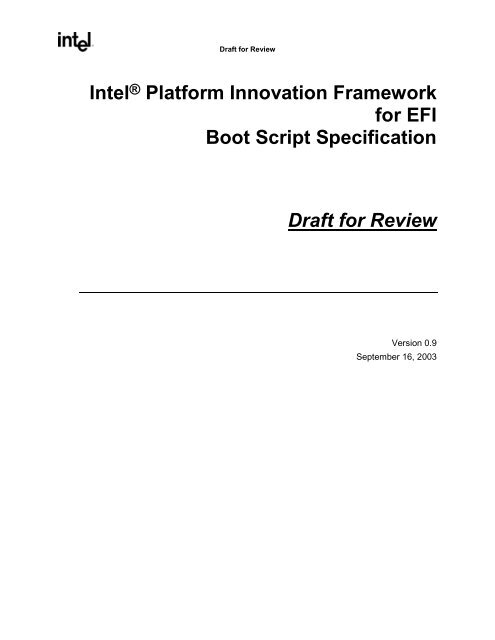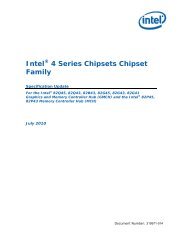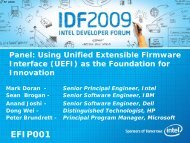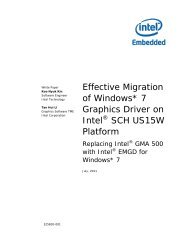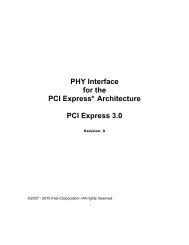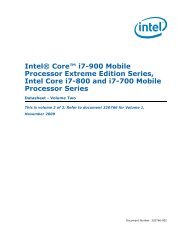Download PDF - Intel
Download PDF - Intel
Download PDF - Intel
You also want an ePaper? Increase the reach of your titles
YUMPU automatically turns print PDFs into web optimized ePapers that Google loves.
Draft for Review<br />
<strong>Intel</strong> ® Platform Innovation Framework<br />
for EFI<br />
Boot Script Specification<br />
Draft for Review<br />
Version 0.9<br />
September 16, 2003
Boot Script Specification<br />
Draft for Review<br />
THIS SPECIFICATION IS PROVIDED "AS IS" WITH NO WARRANTIES WHATSOEVER, INCLUDING ANY WARRANTY<br />
OF MERCHANTABILITY, NONINFRINGEMENT, FITNESS FOR ANY PARTICULAR PURPOSE, OR ANY WARRANTY<br />
OTHERWISE ARISING OUT OF ANY PROPOSAL, SPECIFICATION OR SAMPLE. Except for a limited copyright license<br />
to copy this specification for internal use only, no license, express or implied, by estoppel or otherwise, to any intellectual<br />
property rights is granted herein.<br />
<strong>Intel</strong> disclaims all liability, including liability for infringement of any proprietary rights, relating to implementation of information<br />
in this specification. <strong>Intel</strong> does not warrant or represent that such implementation(s) will not infringe such rights.<br />
Designers must not rely on the absence or characteristics of any features or instructions marked "reserved" or "undefined."<br />
<strong>Intel</strong> reserves these for future definition and shall have no responsibility whatsoever for conflicts or incompatibilities arising<br />
from future changes to them.<br />
This document is an intermediate draft for comment only and is subject to change without notice. Readers should not design<br />
products based on this document.<br />
<strong>Intel</strong>, the <strong>Intel</strong> logo, and Itanium are trademarks or registered trademarks of <strong>Intel</strong> Corporation or its subsidiaries in the United<br />
States and other countries.<br />
* Other names and brands may be claimed as the property of others.<br />
Copyright © 2001–2003, <strong>Intel</strong> Corporation.<br />
<strong>Intel</strong> order number xxxxxx-001<br />
ii September 2003 Version 0.9
Draft for Review<br />
Revision History<br />
Revision Revision History Date<br />
0.9 First public release. 9/16/03<br />
Version 0.9 September 2003 iii
Boot Script Specification<br />
Draft for Review<br />
iv September 2003 Version 0.9
Draft for Review<br />
Contents<br />
1 Introduction ........................................................................................................7<br />
Overview................................................................................................................................7<br />
Requirements ........................................................................................................................7<br />
Conventions Used in This Document.....................................................................................8<br />
Data Structure Descriptions ..........................................................................................8<br />
Protocol Descriptions ....................................................................................................9<br />
Procedure Descriptions.................................................................................................9<br />
PPI Descriptions .........................................................................................................10<br />
Pseudo-Code Conventions .........................................................................................10<br />
Typographic Conventions ...........................................................................................11<br />
2 Design Discussion...........................................................................................13<br />
Framework Boot Script ........................................................................................................13<br />
Boot Script Usage Model .....................................................................................................14<br />
Role of Boot Script in S3 Resume Boot Path .......................................................................14<br />
3 Code Definitions...............................................................................................15<br />
Introduction..........................................................................................................................15<br />
Boot Script Save Protocol ....................................................................................................16<br />
EFI_BOOT_SCRIPT_SAVE_PROTOCOL..................................................................16<br />
EFI_BOOT_SCRIPT_SAVE_PROTOCOL.Write() ......................................................17<br />
Opcodes for Write().....................................................................................................20<br />
EFI_BOOT_SCRIPT_IO_WRITE_OPCODE ................................................20<br />
EFI_BOOT_SCRIPT_IO_READ_WRITE_OPCODE ....................................22<br />
EFI_BOOT_SCRIPT_MEM_WRITE_OPCODE............................................24<br />
EFI_BOOT_SCRIPT_MEM_READ_WRITE_OPCODE................................26<br />
EFI_BOOT_SCRIPT_PCI_CONFIG_WRITE_OPCODE ..............................28<br />
EFI_BOOT_SCRIPT_PCI_CONFIG_READ_WRITE_OPCODE ..................30<br />
EFI_BOOT_SCRIPT_SMBUS_EXECUTE_OPCODE ..................................32<br />
EFI_BOOT_SCRIPT_STALL_OPCODE.......................................................35<br />
EFI_BOOT_SCRIPT_DISPATCH_OPCODE ...............................................36<br />
EFI_BOOT_SCRIPT_SAVE_PROTOCOL.CloseTable().............................................37<br />
Boot Script Executer ............................................................................................................38<br />
Boot Script Executer ............................................................................................................38<br />
EFI_PEI_BOOT_SCRIPT_EXECUTER_PPI...............................................................38<br />
EFI_PEI_BOOT_SCRIPT_EXECUTER_PPI.Execute() ..............................................40<br />
Version 0.9 September 2003 v
Boot Script Specification<br />
Draft for Review<br />
Figures<br />
Figure 2-1. Boot Script Usage Model ...................................................................................14<br />
Figure 2-2. Role of Boot Script Usage in S3 Resume Boot Path..........................................14<br />
Tables<br />
Table 3-1. Opcode PPI Dependencies.................................................................................38<br />
vi September 2003 Version 0.9
Draft for Review<br />
1<br />
Introduction<br />
Overview<br />
This specification defines the core code and services that are required for an implementation of the<br />
boot script in the <strong>Intel</strong>® Platform Innovation Framework for EFI (hereafter referred to as the<br />
“Framework”).The Framework boot script is a script into which configuration information about<br />
the platform is recorded for use during different boot paths.This specification does the following:<br />
• Describes the mechanism that is used to execute and record the boot script<br />
• Provides code definitions for various boot scripts that are architecturally required by the <strong>Intel</strong>®<br />
Platform Innovation Framework for EFI Architecture Specification<br />
Requirements<br />
This Framework boot script design must meet the following requirements:<br />
• All aspects of this design must comply with the following:<br />
⎯ <strong>Intel</strong>® Platform Innovation Framework for EFI Architecture Specification<br />
⎯ <strong>Intel</strong>® Platform Innovation Framework for EFI Pre-EFI Initialization Core Interface<br />
Specification (PEI CIS)<br />
⎯ <strong>Intel</strong>® Platform Innovation Framework for EFI Driver Execution Environment Core<br />
Interface Specification (DXE CIS)<br />
⎯ ACPI 2.0 specification<br />
• The design must enable size efficiency, code reuse, and maintainability.<br />
Version 0.9 September 2003 7
Boot Script Specification<br />
Draft for Review<br />
Conventions Used in This Document<br />
This document uses the typographic and illustrative conventions described below.<br />
Data Structure Descriptions<br />
<strong>Intel</strong> ® processors based on 32-bit <strong>Intel</strong> ® architecture (IA-32) are “little endian” machines.This<br />
distinction means that the low-order byte of a multibyte data item in memory is at the lowest<br />
address, while the high-order byte is at the highest address.Processors of the <strong>Intel</strong> ® Itanium ®<br />
processor family may be configured for both “little endian” and “big endian” operation.All<br />
implementations designed to conform to this specification will use “little endian” operation.<br />
In some memory layout descriptions, certain fields are marked reserved.Software must initialize<br />
such fields to zero and ignore them when read.On an update operation, software must preserve<br />
any reserved field.<br />
The data structures described in this document generally have the following format:<br />
STRUCTURE NAME: The formal name of the data structure.<br />
Summary:<br />
Prototype:<br />
Parameters:<br />
Description:<br />
Related Definitions:<br />
A brief description of the data structure.<br />
A “C-style” type declaration for the data structure.<br />
A brief description of each field in the data structure prototype.<br />
A description of the functionality provided by the data structure,<br />
including any limitations and caveats of which the caller should<br />
be aware.<br />
The type declarations and constants that are used only by<br />
this data structure.<br />
8 September 2003 Version 0.9
Draft for Review<br />
Introduction<br />
Protocol Descriptions<br />
The protocols described in this document generally have the following format:<br />
Protocol Name: The formal name of the protocol interface.<br />
Summary:<br />
GUID:<br />
A brief description of the protocol interface.<br />
The 128-bit Globally Unique Identifier (GUID) for the protocol<br />
interface.<br />
Protocol Interface Structure:<br />
A “C-style” data structure definition containing the procedures<br />
and data fields produced by this protocol interface.<br />
Parameters:<br />
Description:<br />
Related Definitions:<br />
Procedure Descriptions<br />
A brief description of each field in the protocol interface<br />
structure.<br />
A description of the functionality provided by the interface,<br />
including any limitations and caveats of which the caller should<br />
be aware.<br />
The type declarations and constants that are used in the protocol<br />
interface structure or any of its procedures.<br />
The procedures described in this document generally have the following format:<br />
ProcedureName(): The formal name of the procedure.<br />
Summary:<br />
Prototype:<br />
Parameters:<br />
Description:<br />
Related Definitions:<br />
A brief description of the procedure.<br />
A “C-style” procedure header defining the calling sequence.<br />
A brief description of each field in the procedure prototype.<br />
A description of the functionality provided by the interface,<br />
including any limitations and caveats of which the caller should<br />
be aware.<br />
The type declarations and constants that are used only by<br />
this procedure.<br />
Status Codes Returned: A description of any codes returned by the interface.The<br />
procedure is required to implement any status codes listed in this<br />
table.Additional error codes may be returned, but they will not<br />
be tested by standard compliance tests, and any software that<br />
uses the procedure cannot depend on any of the extended error<br />
codes that an implementation may provide.<br />
Version 0.9 September 2003 9
Boot Script Specification<br />
Draft for Review<br />
PPI Descriptions<br />
A PEIM-to-PEIM Interface (PPI) description generally has the following format:<br />
PPI Name: TheformalnameofthePPI.<br />
Summary:<br />
GUID:<br />
A brief description of the PPI.<br />
The 128-bit Globally Unique Identifier (GUID) for the PPI.<br />
PPI Interface Structure: A “C-style” procedure template defining the PPI calling<br />
structure.<br />
Parameters:<br />
A brief description of each field in the PPI structure.<br />
Description:<br />
Related Definitions:<br />
A description of the functionality provided by the interface,<br />
including any limitations and caveats of which the caller<br />
should be aware.<br />
The type declarations and constants that are used only by<br />
this interface.<br />
Status Codes Returned: A description of any codes returned by the interface.The PPI<br />
is required to implement any status codes listed in this table.<br />
Additional error codes may be returned, but they will not be<br />
tested by standard compliance tests, and any software that uses<br />
the procedure cannot depend on any of the extended error codes<br />
that an implementation may provide.<br />
Pseudo-Code Conventions<br />
Pseudo code is presented to describe algorithms in a more concise form.None of the algorithms in<br />
this document are intended to be compiled directly.The code is presented at a level corresponding<br />
to the surrounding text.<br />
In describing variables, a list is an unordered collection of homogeneous objects.A queue is an<br />
ordered list of homogeneous objects.Unless otherwise noted, the ordering is assumed to be First In<br />
First Out (FIFO).<br />
Pseudo code is presented in a C-like format, using C conventions where appropriate.The coding<br />
style, particularly the indentation style, is used for readability and does not necessarily comply with<br />
an implementation of the Extensible Firmware Interface Specification.<br />
10 September 2003 Version 0.9
Draft for Review<br />
Introduction<br />
Typographic Conventions<br />
This document uses the typographic and illustrative conventions described below:<br />
Plain text<br />
The normal text typeface is used for the vast majority of the descriptive<br />
text in a specification.<br />
Plain text (blue) In the online help version of this specification, any plain text that is<br />
underlined and in blue indicates an active link to the cross-reference.<br />
Click on the word to follow the hyperlink.Note that these links are not<br />
active in the <strong>PDF</strong> of the specification.<br />
Bold<br />
In text, a Bold typeface identifies a processor register name.In other<br />
instances, a Bold typeface can be used as a running head within a<br />
paragraph.<br />
Italic<br />
In text, an Italic typeface can be used as emphasis to introduce a new<br />
term or to indicate a manual or specification name.<br />
BOLD Monospace Computer code, example code segments, and all prototype code<br />
segments use a BOLD Monospace typeface with a dark red color.<br />
These code listings normally appear in one or more separate paragraphs,<br />
though words or segments can also be embedded in a normal text<br />
paragraph.<br />
Bold Monospace In the online help version of this specification, words in a<br />
Bold Monospace typeface that is underlined and in blue indicate an<br />
active hyperlink to the code definition for that function or type definition.<br />
Click on the word to follow the hyperlink.Note that these links are not<br />
active in the <strong>PDF</strong> of the specification.Also, these inactive links in the<br />
<strong>PDF</strong> may instead have a Bold Monospace appearance that is<br />
underlined but in dark red.Again, these links are not active in the <strong>PDF</strong> of<br />
the specification.<br />
Italic Monospace In code or in text, words in Italic Monospace indicate placeholder<br />
names for variable information that must be supplied (i.e., arguments).<br />
Plain Monospace In code, words in a Plain Monospace typeface that is a dark red<br />
color but is not bold or italicized indicate pseudo code or example code.<br />
These code segments typically occur in one or more separate paragraphs.<br />
See the master Framework glossary in the Framework Interoperability and Component<br />
Specifications help system for definitions of terms and abbreviations that are used in this document<br />
or that might be useful in understanding the descriptions presented in this document.<br />
See the master Framework references in the Interoperability and Component Specifications help<br />
system for a complete list of the additional documents and specifications that are required or<br />
suggested for interpreting the information presented in this document.<br />
The Framework Interoperability and Component Specifications help system is available at the<br />
following URL:<br />
http://www.intel.com/technology/framework/spec.htm<br />
Version 0.9 September 2003 11
Boot Script Specification<br />
Draft for Review<br />
12 September 2003 Version 0.9
Draft for Review<br />
2<br />
Design Discussion<br />
Framework Boot Script<br />
The Framework boot script is intended to generalize the process of platform initialization in that it<br />
can be viewed as a sequence of the following:<br />
• Accessing the I/O, memory, and PCI configuration space<br />
• Executing specific microprocessor instructions<br />
The Framework boot script is especially useful in a resume from the Advanced Configuration and<br />
Power Interface (ACPI) S3 system sleep state.During a normal boot, the Framework initializes the<br />
platform in a phased fashion.In the Pre-EFI Initialization (PEI) phase, the Framework initializes<br />
the platform with enough configurations to allow execution of the Driver Execution Environment<br />
(DXE) phase.During the DXE phase, numerous DXE drivers collectively continue to configure the<br />
platform to a final preboot state.In contrast, in the ACPI resume boot path, the Framework needs to<br />
restore configuration done in both the PEI and DXE phases.<br />
However, it is not effective to make the DXE phase aware of the boot path because the time that<br />
is allotted to complete an S3 resume is very constrained; Microsoft* requires 0.5 seconds. To avoid<br />
the DXE phase in an S3 resume, various chipset drivers record information on the following as a<br />
boot script:<br />
• I/O<br />
• PCI<br />
• Memory<br />
• System Management Bus (SMBus)<br />
• Other specific operations or routines that are necessary to restore the chipset and<br />
processor configuration<br />
This boot script can be copied into a nonvolatile storage (NVS) memory region.When the system<br />
wakes up and runs the S3 resume boot path, a boot script engine Pre-EFI Initialization Module<br />
(PEIM) is able to execute the boot script to restore the configuration done in the previous<br />
DXE phase.<br />
See the next topics for figures showing how the boot script works in a normal boot path and during<br />
an S3 resume.<br />
Version 0.9 September 2003 13
Boot Script Specification<br />
Draft for Review<br />
Boot Script Usage Model<br />
The figure below shows how the boot script works in a normal boot path and during an S3 resume.<br />
DXE chipset driver<br />
in normal boot<br />
path<br />
Boot Script Engine<br />
PEIM in S3<br />
resume boot path<br />
Execute<br />
Call<br />
EFI_BOOT_<br />
SCRIPT_SAVE_<br />
PROTOCOL<br />
Produce<br />
EFIBootScript<br />
Tablestoredin<br />
ACPI NVS<br />
memory<br />
Figure 2-1.Boot Script Usage Model<br />
Role of Boot Script in S3 Resume Boot Path<br />
The figure below shows the role of the boot script and the boot script table in a normal boot path<br />
and the S3 resume boot path.<br />
Normal Boot<br />
SEC PEI DXE BDS<br />
OS load<br />
Save<br />
Boot Script<br />
TableinACPI<br />
NVS<br />
Execute<br />
S3 Resume<br />
SEC<br />
PEI<br />
(S3-aware<br />
PEIM to restore<br />
PEI phase<br />
configuration)<br />
Boot Script<br />
PEIM to<br />
restore DXE<br />
phase<br />
configuration<br />
OS waking vector<br />
Figure 2-2.Role of Boot Script Usage in S3 Resume Boot Path<br />
14 September 2003 Version 0.9
Draft for Review<br />
Introduction<br />
3<br />
Code Definitions<br />
This section contains the basic definitions for storing firmware volumes in block access type<br />
devices.The following protocols, PPIs, and their respective member functions are defined in<br />
this section:<br />
• EFI_BOOT_SCRIPT_SAVE_PROTOCOL<br />
• EFI_PEI_BOOT_SCRIPT_EXECUTER_PPI<br />
This section also contains the definitions for additional data types and structures that are<br />
subordinate to the structures in which they are called.The following types or structures can be<br />
found in “Related Definitions” of the parent data structure, protocol, or function definition:<br />
• EFI_ACPI_S3_RESUME_SCRIPT_TABLE<br />
• Boot script opcode definitions<br />
• EFI_BOOT_SCRIPT_WIDTH<br />
• EFI_SMBUS_DEVICE_ADDRESS<br />
• EFI_SMBUS_DEVICE_COMMAND<br />
• EFI_SMBUS_OPERATION<br />
Version 0.9 September 2003 15
Boot Script Specification<br />
Draft for Review<br />
Boot Script Save Protocol<br />
EFI_BOOT_SCRIPT_SAVE_PROTOCOL<br />
Summary<br />
Used to store or record various boot scripts into boot script tables.<br />
GUID<br />
#define EFI_BOOT_SCRIPT_SAVE_GUID \<br />
{ 0x470e1529, 0xb79e, 0x4e32, 0xa0, 0xfe, 0x6a,0x15, 0x6d, 0x29,<br />
0xf9, 0xb2 }<br />
Protocol Interface Structure<br />
typedef struct _EFI_BOOT_SCRIPT_SAVE_PROTOCOL {<br />
EFI_BOOT_SCRIPT_WRITE<br />
Write;<br />
EFI_BOOT_SCRIPT_CLOSE_TABLE<br />
CloseTable;<br />
} EFI_BOOT_SCRIPT_SAVE_PROTOCOL;<br />
Parameters<br />
Write<br />
Writes various boot scripts to a boot script table.See the Write() function<br />
description.<br />
CloseTable<br />
Retrieves and closes a script table.See the CloseTable() function description.<br />
Description<br />
The EFI_BOOT_SCRIPT_SAVE_PROTOCOL publishes the Framework boot script abstractions.<br />
This protocol is not required for all platforms.<br />
This protocol allows different drivers to record boot scripts.There are different types of boot<br />
scripts, which are then grouped into tables.Currently the only meaningful table is for the<br />
S3 resume boot path.The implementer can also choose to hide this protocol behind a DXE library.<br />
16 September 2003 Version 0.9
Draft for Review<br />
Code Definitions<br />
EFI_BOOT_SCRIPT_SAVE_PROTOCOL.Write()<br />
Summary<br />
Adds a record into a specified Framework boot script table.<br />
Prototype<br />
typedef<br />
EFI_STATUS<br />
(EFIAPI *EFI_BOOT_SCRIPT_WRITE) (<br />
IN struct _EFI_BOOT_SCRIPT_SAVE_PROTOCOL<br />
IN UINT16<br />
IN UINT16<br />
...<br />
);<br />
*This,<br />
TableName,<br />
OpCode,<br />
Parameters<br />
This<br />
A pointer to the EFI_BOOT_SCRIPT_SAVE_PROTOCOL instance.<br />
TableName<br />
Name of the script table.Currently, the only meaningful value is<br />
EFI_ACPI_S3_RESUME_SCRIPT_TABLE.Type<br />
EFI_ACPI_S3_RESUME_SCRIPT_TABLE is defined in “Related<br />
Definitions” below.<br />
OpCode<br />
The operation code (opcode) number.See “Related Definitions” below for<br />
the defined opcode types.<br />
…<br />
Argument list that is specific to each opcode.See the following subsections<br />
for the definition of each opcode.<br />
Description<br />
This function is used to store a boot script record into a given boot script table.If the table specified<br />
by TableName is nonexistent in the system, a new table will automatically be created and then<br />
the script record will be added into the new table.A boot script table can add new script records<br />
until EFI_BOOT_SCRIPT_SAVE_PROTOCOL.CloseTable() is called.Currently, the only<br />
meaningful table name is EFI_ACPI_S3_RESUME_SCRIPT_TABLE.This function is<br />
responsible for allocating necessary memory for the script.<br />
This function has a variable parameter list.The exact parameter list depends on the OpCode that is<br />
passed into the function.If an unsupported OpCode or illegal parameter list is passed in, this<br />
function returns EFI_INVALID_PARAMETER.<br />
If there are not enough resources available for storing more scripts, this function returns<br />
EFI_OUT_OF_RESOURCES.<br />
Version 0.9 September 2003 17
Boot Script Specification<br />
Draft for Review<br />
Related Definitions<br />
//*******************************************<br />
// EFI_ACPI_S3_RESUME_SCRIPT_TABLE<br />
//*******************************************<br />
#define EFI_ACPI_S3_RESUME_SCRIPT_TABLE<br />
0x00<br />
//*******************************************<br />
// EFI Boot Script Opcode definitions<br />
//*******************************************<br />
NOTE<br />
Click the links in the #define statements below to jump to the Write() function description for<br />
that opcode.<br />
#define EFI_BOOT_SCRIPT_IO_WRITE_OPCODE<br />
#define EFI_BOOT_SCRIPT_IO_READ_WRITE_OPCODE<br />
#define EFI_BOOT_SCRIPT_MEM_WRITE_OPCODE<br />
#define EFI_BOOT_SCRIPT_MEM_READ_WRITE_OPCODE<br />
#define EFI_BOOT_SCRIPT_PCI_CONFIG_WRITE_OPCODE<br />
#define EFI_BOOT_SCRIPT_PCI_CONFIG_READ_WRITE_OPCODE<br />
#define EFI_BOOT_SCRIPT_SMBUS_EXECUTE_OPCODE<br />
#define EFI_BOOT_SCRIPT_STALL_OPCODE<br />
#define EFI_BOOT_SCRIPT_DISPATCH_OPCODE<br />
0x00<br />
0x01<br />
0x02<br />
0x03<br />
0x04<br />
0x05<br />
0x06<br />
0x07<br />
0x08<br />
//*******************************************<br />
// EFI_BOOT_SCRIPT_WIDTH<br />
//*******************************************<br />
typedef enum {<br />
EfiBootScriptWidthUint8,<br />
EfiBootScriptWidthUint16,<br />
EfiBootScriptWidthUint32,<br />
EfiBootScriptWidthUint64,<br />
EfiBootScriptWidthFifoUint8,<br />
EfiBootScriptWidthFifoUint16,<br />
EfiBootScriptWidthFifoUint32,<br />
EfiBootScriptWidthFifoUint64,<br />
EfiBootScriptWidthFillUint8,<br />
EfiBootScriptWidthFillUint16,<br />
EfiBootScriptWidthFillUint32,<br />
EfiBootScriptWidthFillUint64,<br />
EfiBootScriptWidthMaximum<br />
} EFI_BOOT_SCRIPT_WIDTH;<br />
18 September 2003 Version 0.9
Draft for Review<br />
Code Definitions<br />
Status Codes Returned<br />
EFI_SUCCESS<br />
EFI_INVALID_PARAMETER<br />
EFI_OUT_OF_RESOURCES<br />
The operation succeeded. A record was added into the<br />
specified script table.<br />
The parameter is illegal or the given boot script is not supported.<br />
There is insufficient memory to store the boot script.<br />
Version 0.9 September 2003 19
Boot Script Specification<br />
Draft for Review<br />
Opcodes for Write()<br />
EFI_BOOT_SCRIPT_IO_WRITE_OPCODE<br />
Summary<br />
Adds a record for an I/O write operation into a specified boot script table.<br />
Prototype<br />
typedef<br />
EFI_STATUS<br />
(EFIAPI *EFI_BOOT_SCRIPT_WRITE) (<br />
IN struct _EFI_BOOT_SCRIPT_SAVE_PROTOCOL *This,<br />
IN UINT16 TableName,<br />
IN UINT16 OpCode,<br />
IN EFI_BOOT_SCRIPT_WIDTH Width,<br />
IN UINT64 Address,<br />
IN UINTN Count,<br />
IN VOID *Buffer<br />
);<br />
Parameters<br />
This<br />
A pointer to the EFI_BOOT_SCRIPT_SAVE_PROTOCOL instance.<br />
TableName<br />
Name of the script table.Currently, the only meaningful value<br />
is EFI_ACPI_S3_RESUME_SCRIPT_TABLE.Type<br />
EFI_ACPI_S3_RESUME_SCRIPT_TABLE is defined in “Related Definitions” in<br />
EFI_BOOT_SCRIPT_SAVE_PROTOCOL.Write().<br />
OpCode<br />
Must be set to EFI_BOOT_SCRIPT_IO_WRITE_OPCODE.Type<br />
EFI_BOOT_SCRIPT_IO_WRITE_OPCODE is defined in “Related Definitions” in<br />
EFI_BOOT_SCRIPT_SAVE_PROTOCOL.Write().<br />
Width<br />
The width of the I/O operations.Enumerated in EFI_BOOT_SCRIPT_WIDTH.<br />
Type EFI_BOOT_SCRIPT_WIDTH is defined in “Related Definitions” in<br />
EFI_BOOT_SCRIPT_SAVE_PROTOCOL.Write().<br />
Address<br />
The base address of the I/O operations.<br />
20 September 2003 Version 0.9
Draft for Review<br />
Code Definitions<br />
Count<br />
The number of I/O operations to perform.The number of bytes moved is Width<br />
size * Count, starting at Address.<br />
Buffer<br />
The source buffer from which to write data.The buffer size is<br />
Width size * Count.<br />
Description<br />
This function adds an I/O write record into a specified boot script table.On script execution, this<br />
operation writes the presaved value into the specified I/O ports.<br />
Status Codes Returned<br />
See “Status Codes Returned” inWrite().<br />
Version 0.9 September 2003 21
Boot Script Specification<br />
Draft for Review<br />
EFI_BOOT_SCRIPT_IO_READ_WRITE_OPCODE<br />
Summary<br />
Adds a record for an I/O modify operation into a specified boot script table.<br />
Prototype<br />
typedef<br />
EFI_STATUS<br />
(EFIAPI *EFI_BOOT_SCRIPT_WRITE) (<br />
IN struct _EFI_BOOT_SCRIPT_SAVE_PROTOCOL *This,<br />
IN UINT16 TableName,<br />
IN UINT16 OpCode,<br />
IN EFI_BOOT_SCRIPT_WIDTH Width,<br />
IN UINT64 Address,<br />
IN VOID *Data,<br />
IN VOID *DataMask<br />
);<br />
Parameters<br />
This<br />
A pointer to the EFI_BOOT_SCRIPT_SAVE_PROTOCOL instance.<br />
TableName<br />
Name of the script table.Currently, the only meaningful value<br />
is EFI_ACPI_S3_RESUME_SCRIPT_TABLE.Type<br />
EFI_ACPI_S3_RESUME_SCRIPT_TABLE is defined in “Related Definitions” in<br />
EFI_BOOT_SCRIPT_SAVE_PROTOCOL.Write().<br />
OpCode<br />
Must be set to EFI_BOOT_SCRIPT_IO_READ_WRITE_OPCODE.Type<br />
EFI_BOOT_SCRIPT_IO_READ_WRITE_OPCODE is defined in “Related<br />
Definitions” in EFI_BOOT_SCRIPT_SAVE_PROTOCOL.Write().<br />
Width<br />
The width of the I/O operations.Enumerated in EFI_BOOT_SCRIPT_WIDTH.<br />
Type EFI_BOOT_SCRIPT_WIDTH is defined in “Related Definitions” in<br />
EFI_BOOT_SCRIPT_SAVE_PROTOCOL.Write().<br />
Address<br />
The base address of the I/O operations.<br />
Data<br />
A pointer to the data to be OR-ed.<br />
DataMask<br />
A pointer to the data mask to be AND-ed with the data read from the register.<br />
22 September 2003 Version 0.9
Draft for Review<br />
Code Definitions<br />
Description<br />
This function adds an I/O read and write record into the specified boot script table.When the script<br />
is executed, the register at Address is read, AND-ed with DataMask,andOR-ed with Data,and<br />
finally the result is written back.<br />
Status Codes Returned<br />
See “Status Codes Returned” inWrite().<br />
Version 0.9 September 2003 23
Boot Script Specification<br />
Draft for Review<br />
EFI_BOOT_SCRIPT_MEM_WRITE_OPCODE<br />
Summary<br />
Adds a record for a memory write operation into a specified boot script table.<br />
Prototype<br />
typedef<br />
EFI_STATUS<br />
(EFIAPI *EFI_BOOT_SCRIPT_WRITE) (<br />
IN struct _EFI_BOOT_SCRIPT_SAVE_PROTOCOL *This,<br />
IN UINT16 TableName,<br />
IN UINT16 OpCode,<br />
IN EFI_BOOT_SCRIPT_WIDTH Width,<br />
IN UINT64 Address,<br />
IN UINTN Count,<br />
IN VOID *Buffer<br />
);<br />
Parameters<br />
This<br />
A pointer to the EFI_BOOT_SCRIPT_SAVE_PROTOCOL instance.<br />
TableName<br />
Name of the script table.Currently, the only meaningful value<br />
is EFI_ACPI_S3_RESUME_SCRIPT_TABLE.Type<br />
EFI_ACPI_S3_RESUME_SCRIPT_TABLE is defined in “Related Definitions” in<br />
EFI_BOOT_SCRIPT_SAVE_PROTOCOL.Write().<br />
OpCode<br />
Must be set to EFI_BOOT_SCRIPT_MEM_WRITE_OPCODE.Type<br />
EFI_BOOT_SCRIPT_MEM_WRITE_OPCODE is defined in “Related Definitions”<br />
in EFI_BOOT_SCRIPT_SAVE_PROTOCOL.Write().<br />
Width<br />
The width of the memory operations.Enumerated in EFI_BOOT_SCRIPT_WIDTH.<br />
Type EFI_BOOT_SCRIPT_WIDTH is defined in “Related Definitions” in<br />
EFI_BOOT_SCRIPT_SAVE_PROTOCOL.Write().<br />
Address<br />
The base address of the memory operations. Address needs alignment if required.<br />
24 September 2003 Version 0.9
Draft for Review<br />
Code Definitions<br />
Count<br />
The number of memory operations to perform.The number of bytes moved is<br />
Width size * Count,startingatAddress.<br />
Buffer<br />
The source buffer from which to write the data.The buffer size is<br />
Width size * Count.<br />
Description<br />
This function adds a memory write record into a specified boot script table.When the script is<br />
executed, this operation writes the presaved value into the specified memory location.<br />
Status Codes Returned<br />
See “Status Codes Returned” inWrite().<br />
Version 0.9 September 2003 25
Boot Script Specification<br />
Draft for Review<br />
EFI_BOOT_SCRIPT_MEM_READ_WRITE_OPCODE<br />
Summary<br />
Adds a record for a memory modify operation into a specified boot script table.<br />
Prototype<br />
typedef<br />
EFI_STATUS<br />
(EFIAPI *EFI_BOOT_SCRIPT_WRITE) (<br />
IN struct _EFI_BOOT_SCRIPT_SAVE_PROTOCOL *This,<br />
IN UINT16 TableName,<br />
IN UINT16 OpCode,<br />
IN EFI_BOOT_SCRIPT_WIDTH Width,<br />
IN UINT64 Address,<br />
IN VOID *Data,<br />
IN VOID *DataMask<br />
);<br />
Parameters<br />
This<br />
A pointer to the EFI_BOOT_SCRIPT_SAVE_PROTOCOL instance.<br />
TableName<br />
Name of the script table.Currently, the only meaningful value<br />
is EFI_ACPI_S3_RESUME_SCRIPT_TABLE.Type<br />
EFI_ACPI_S3_RESUME_SCRIPT_TABLE is defined in “Related Definitions” in<br />
EFI_BOOT_SCRIPT_SAVE_PROTOCOL.Write().<br />
OpCode<br />
Must be set to EFI_BOOT_SCRIPT_MEM_READ_WRITE_OPCODE.Type<br />
EFI_BOOT_SCRIPT_MEM_READ_WRITE_OPCODE is defined in “Related<br />
Definitions” in EFI_BOOT_SCRIPT_SAVE_PROTOCOL.Write().<br />
Width<br />
The width of the memory operations.Enumerated in EFI_BOOT_SCRIPT_WIDTH.<br />
Type EFI_BOOT_SCRIPT_WIDTH is defined in “Related Definitions” in<br />
EFI_BOOT_SCRIPT_SAVE_PROTOCOL.Write().<br />
Address<br />
The base address of the memory operations. Address needs alignment if required.<br />
Data<br />
A pointer to the data to be OR-ed.<br />
DataMask<br />
A pointer to the data mask to be AND-ed with the data read from the register.<br />
26 September 2003 Version 0.9
Draft for Review<br />
Code Definitions<br />
Description<br />
This function adds a memory read and write record into a specified boot script table.When the<br />
script is executed, the memory at Address is read, AND-ed with DataMask, andOR-ed with<br />
Data, and finally the result is written back.<br />
Status Codes Returned<br />
See “Status Codes Returned” inWrite().<br />
Version 0.9 September 2003 27
Boot Script Specification<br />
Draft for Review<br />
EFI_BOOT_SCRIPT_PCI_CONFIG_WRITE_OPCODE<br />
Summary<br />
Adds a record for a PCI configuration space write operation into a specified boot script table.<br />
Prototype<br />
typedef<br />
EFI_STATUS<br />
(EFIAPI *EFI_BOOT_SCRIPT_WRITE) (<br />
IN struct _EFI_BOOT_SCRIPT_SAVE_PROTOCOL *This,<br />
IN UINT16 TableName,<br />
IN UINT16 OpCode,<br />
IN EFI_BOOT_SCRIPT_WIDTH Width,<br />
IN UINT64 Address,<br />
IN UINTN Count,<br />
IN VOID *Buffer<br />
)<br />
Parameters<br />
This<br />
A pointer to the EFI_BOOT_SCRIPT_SAVE_PROTOCOL instance.<br />
TableName<br />
Name of the script table.Currently, the only meaningful value is<br />
EFI_ACPI_S3_RESUME_SCRIPT_TABLE.Type<br />
EFI_ACPI_S3_RESUME_SCRIPT_TABLE is defined in “Related Definitions”<br />
in EFI_BOOT_SCRIPT_SAVE_PROTOCOL.Write().<br />
OpCode<br />
Must be set to EFI_BOOT_SCRIPT_PCI_CONFIG_WRITE_OPCODE.Type<br />
EFI_BOOT_SCRIPT_PCI_CONFIG_WRITE_OPCODE is defined in “Related<br />
Definitions” in EFI_BOOT_SCRIPT_SAVE_PROTOCOL.Write().<br />
Width<br />
The width of the PCI operations.Enumerated in EFI_BOOT_SCRIPT_WIDTH.<br />
Type EFI_BOOT_SCRIPT_WIDTH is defined in “Related Definitions” in<br />
EFI_BOOT_SCRIPT_SAVE_PROTOCOL.Write().<br />
Address<br />
The address within the PCI configuration space.See Table 12-1 in the Extensible<br />
Firmware Interface Specification, version 1.10, for the address format.<br />
28 September 2003 Version 0.9
Draft for Review<br />
Code Definitions<br />
Count<br />
The number of PCI operations to perform.The number of bytes moved is<br />
Width size * Count,startingatAddress.<br />
Buffer<br />
The source buffer from which to write the data.The buffer size is Width size<br />
* Count.<br />
Description<br />
This function adds a PCI configuration space write record into a specified boot script table.When<br />
the script is executed, this operation writes the presaved value into the specified location in PCI<br />
configuration space.<br />
Status Codes Returned<br />
See “Status Codes Returned” inWrite().<br />
Version 0.9 September 2003 29
Boot Script Specification<br />
Draft for Review<br />
EFI_BOOT_SCRIPT_PCI_CONFIG_READ_WRITE_OPCODE<br />
Summary<br />
Adds a record for a PCI configuration space modify operation into a specified boot script table.<br />
Prototype<br />
typedef<br />
EFI_STATUS<br />
(EFIAPI *EFI_BOOT_SCRIPT_WRITE) (<br />
IN struct _EFI_BOOT_SCRIPT_SAVE_PROTOCOL *This,<br />
IN UINT16 TableName,<br />
IN UINT16 OpCode,<br />
IN EFI_BOOT_SCRIPT_WIDTH Width,<br />
IN UINT64 Address,<br />
IN VOID *Data,<br />
IN VOID *DataMask<br />
)<br />
Parameters<br />
This<br />
A pointer to the EFI_BOOT_SCRIPT_SAVE_PROTOCOL instance.<br />
TableName<br />
Name of the script table.Currently, the only meaningful value is<br />
EFI_ACPI_S3_RESUME_SCRIPT_TABLE.Type<br />
EFI_ACPI_S3_RESUME_SCRIPT_TABLE is defined in “Related Definitions” in<br />
EFI_BOOT_SCRIPT_SAVE_PROTOCOL.Write().<br />
OpCode<br />
Must be set to EFI_BOOT_SCRIPT_PCI_CONFIG_READ_WRITE_OPCODE.<br />
Type EFI_BOOT_SCRIPT_PCI_CONFIG_READ_WRITE_OPCODE is defined in<br />
“Related Definitions” in EFI_BOOT_SCRIPT_SAVE_PROTOCOL.Write().<br />
Width<br />
The width of the PCI operations.Enumerated in EFI_BOOT_SCRIPT_WIDTH.<br />
Type EFI_BOOT_SCRIPT_WIDTH is defined in “Related Definitions” in<br />
EFI_BOOT_SCRIPT_SAVE_PROTOCOL.Write().<br />
Address<br />
The address within the PCI configuration space.See Table 12-1 in the Extensible<br />
Firmware Interface Specification, version 1.10, for the address format.<br />
Data<br />
A pointer to the data to be OR-ed.The size depends on Width.<br />
DataMask<br />
A pointer to the data mask to be AND-ed.<br />
30 September 2003 Version 0.9
Draft for Review<br />
Code Definitions<br />
Description<br />
This function adds a PCI configuration read and write record into a specified boot script table.<br />
When the script is executed, the PCI configuration space location at Address is read, AND-ed<br />
with DataMask,andOR-ed with, and finally the result is written back.<br />
Status Codes Returned<br />
See “Status Codes Returned” inWrite().<br />
Version 0.9 September 2003 31
Boot Script Specification<br />
Draft for Review<br />
EFI_BOOT_SCRIPT_SMBUS_EXECUTE_OPCODE<br />
Summary<br />
Adds a record for an SMBus command execution into a specified boot script table.<br />
Prototype<br />
typedef<br />
EFI_STATUS<br />
(EFIAPI *EFI_BOOT_SCRIPT_WRITE) (<br />
IN struct _EFI_BOOT_SCRIPT_SAVE_PROTOCOL<br />
IN UINT16<br />
IN UINT16<br />
IN EFI_SMBUS_DEVICE_ADDRESS<br />
IN EFI_SMBUS_DEVICE_COMMAND<br />
IN EFI_SMBUS_OPERATION<br />
IN BOOLEAN<br />
IN UINTN<br />
IN VOID<br />
)<br />
*This,<br />
TableName,<br />
OpCode,<br />
SlaveAddress,<br />
Command,<br />
Operation,<br />
PecCheck,<br />
*Length,<br />
*Buffer<br />
Parameters<br />
This<br />
A pointer to the EFI_BOOT_SCRIPT_SAVE_PROTOCOL instance.<br />
TableName<br />
Name of the script table.Currently, the only meaningful value<br />
is EFI_ACPI_S3_RESUME_SCRIPT_TABLE.Type<br />
EFI_ACPI_S3_RESUME_SCRIPT_TABLE is defined in “Related Definitions” in<br />
EFI_BOOT_SCRIPT_SAVE_PROTOCOL.Write().<br />
OpCode<br />
Must be set to BOOT_SCRIPT_SMBUS_EXECUTE_OPCODE.Type<br />
EFI_BOOT_SCRIPT_SMBUS_EXECUTE_OPCODE is defined in “Related<br />
Definitions” in EFI_BOOT_SCRIPT_SAVE_PROTOCOL.Write().<br />
SlaveAddress<br />
The SMBus address for the slave device that the operation is targeting.Type<br />
EFI_SMBUS_DEVICE_ADDRESS is defined in “Related Definitions” below.<br />
Command<br />
The command that is transmitted by the SMBus host controller to the SMBus slave<br />
device.The interpretation is SMBus slave device specific.It can mean the offset to a<br />
list of functions inside an SMBus slave device.Type<br />
EFI_SMBUS_DEVICE_COMMAND is defined in “Related Definitions” below.<br />
32 September 2003 Version 0.9
Draft for Review<br />
Code Definitions<br />
Operation<br />
Indicates which particular SMBus protocol it will use to execute the SMBus<br />
transactions.Type EFI_SMBUS_OPERATION is defined in “Related Definitions”<br />
below.<br />
PecCheck<br />
Defines if Packet Error Code (PEC) checking is required for this operation.<br />
Length<br />
A pointer to signify the number of bytes that this operation will do.<br />
Buffer<br />
Contains the value of data to execute to the SMBUS slave device.<br />
Description<br />
This function adds an SMBus command execution record into a specified boot script table.When<br />
the script is executed, this operation executes a specified SMBus command.<br />
Related Definitions<br />
//************************************************<br />
// EFI_SMBUS_DEVICE_ADDRESS<br />
//************************************************<br />
typedef struct _EFI_SMBUS_DEVICE_ADDRESS {<br />
UINTN SmbusDeviceAddress:7;<br />
} EFI_SMBUS_DEVICE_ADDRESS;<br />
//************************************************<br />
// EFI_SMBUS_DEVICE_COMMAND<br />
//************************************************<br />
typedef UINTN EFI_SMBUS_DEVICE_COMMAND;<br />
Version 0.9 September 2003 33
Boot Script Specification<br />
Draft for Review<br />
//************************************************<br />
// EFI_SMBUS_OPERATION<br />
//************************************************<br />
typedef enum _EFI_SMBUS_OPERATION {<br />
EfiSmbusQuickRead,<br />
EfiSmbusQuickWrite,<br />
EfiSmbusReceiveByte,<br />
EfiSmbusSendByte,<br />
EfiSmbusReadByte,<br />
EfiSmbusWriteByte,<br />
EfiSmbusReadWord,<br />
EfiSmbusWriteWord,<br />
EfiSmbusReadBlock,<br />
EfiSmbusWriteBlock,<br />
EfiSmbusProcessCall,<br />
EfiSmbusBWBRProcessCall<br />
} EFI_SMBUS_OPERATION;<br />
Status Codes Returned<br />
See “Status Codes Returned” inWrite().<br />
34 September 2003 Version 0.9
Draft for Review<br />
Code Definitions<br />
EFI_BOOT_SCRIPT_STALL_OPCODE<br />
Summary<br />
Adds a record for an execution stall on the processor into a specified boot script table.<br />
Prototype<br />
typedef<br />
EFI_STATUS<br />
(EFIAPI *EFI_BOOT_SCRIPT_WRITE) (<br />
IN struct _EFI_BOOT_SCRIPT_SAVE_PROTOCOL *This,<br />
IN UINT16 TableName,<br />
IN UINT16 OpCode,<br />
IN UINTN Duration<br />
)<br />
Parameters<br />
This<br />
A pointer to the EFI_BOOT_SCRIPT_SAVE_PROTOCOL instance.<br />
TableName<br />
Name of the script table.Currently, the only meaningful value is<br />
EFI_ACPI_S3_RESUME_SCRIPT_TABLE.Type<br />
EFI_ACPI_S3_RESUME_SCRIPT_TABLE is defined in “Related Definitions”<br />
in EFI_BOOT_SCRIPT_SAVE_PROTOCOL.Write().<br />
OpCode<br />
Must be set to EFI_BOOT_SCRIPT_STALL_OPCODE.Type<br />
EFI_BOOT_SCRIPT_STALL_OPCODE is defined in “Related Definitions” in<br />
EFI_BOOT_SCRIPT_SAVE_PROTOCOL.Write().<br />
Duration<br />
Duration in microseconds of the stall.<br />
Description<br />
This function adds a stall record into a specified boot script table.When the script is executed, this<br />
operation will stall the system for Duration number of microseconds.<br />
Status Codes Returned<br />
See “Status Codes Returned” inWrite().<br />
Version 0.9 September 2003 35
Boot Script Specification<br />
Draft for Review<br />
EFI_BOOT_SCRIPT_DISPATCH_OPCODE<br />
Summary<br />
Adds a record for dispatching specified arbitrary code into a specified boot script table.<br />
Prototype<br />
typedef<br />
EFI_STATUS<br />
(EFIAPI *EFI_BOOT_SCRIPT_WRITE) (<br />
IN struct _EFI_BOOT_SCRIPT_SAVE_PROTOCOL *This,<br />
IN UINT16 TableName,<br />
IN UINT16 OpCode,<br />
IN EFI_PHYSICAL_ADDRESS EntryPoint<br />
)<br />
Parameters<br />
This<br />
A pointer to the EFI_BOOT_SCRIPT_SAVE_PROTOCOL instance.<br />
TableName<br />
Name of the script table.Currently, the only meaningful value<br />
is EFI_ACPI_S3_RESUME_SCRIPT_TABLE.Type<br />
EFI_ACPI_S3_RESUME_SCRIPT_TABLE is defined in “Related Definitions” in<br />
EFI_BOOT_SCRIPT_SAVE_PROTOCOL.Write().<br />
OpCode<br />
Must be set to EFI_BOOT_SCRIPT_DISPATCH_OPCODE.Type<br />
EFI_BOOT_SCRIPT_DISPATCH_OPCODE is defined in “Related Definitions” in<br />
EFI_BOOT_SCRIPT_SAVE_PROTOCOL.Write().<br />
EntryPoint<br />
Entry point of the code to be dispatched.Type EFI_PHYSICAL_ADDRESS is<br />
defined in AllocatePages() in the EFI 1.10 Specification.<br />
Description<br />
This function adds a dispatch record into a specified boot script table, with which it can run the<br />
arbitrary code that is specified.This script can be used to initialize the processor.When the script is<br />
executed, the script incurs jumping to the entry point to execute the arbitrary code.After the<br />
execution is returned, it goes on executing the next opcode in the table.If the codes to be<br />
dispatched have dependencies on other PPIs or codes, the caller should guarantee that all<br />
dependencies are sufficient before dispatching the codes.<br />
Status Codes Returned<br />
See “Status Codes Returned” inWrite().<br />
36 September 2003 Version 0.9
Draft for Review<br />
Code Definitions<br />
EFI_BOOT_SCRIPT_SAVE_PROTOCOL.CloseTable()<br />
Summary<br />
Closes the specified script table.<br />
Prototype<br />
typedef<br />
EFI_STATUS<br />
(EFIAPI *EFI_BOOT_SCRIPT_CLOSE_TABLE) (<br />
IN struct _EFI_BOOT_SCRIPT_SAVE_PROTOCOL *This,<br />
IN UINT16 TableName,<br />
OUT EFI_PHYSICAL_ADDRESS<br />
*Address<br />
);<br />
Parameters<br />
This<br />
A pointer to the EFI_BOOT_SCRIPT_SAVE_PROTOCOL instance.<br />
TableName<br />
Name of the table.<br />
Address<br />
A pointer to the physical address where the table begins.Type<br />
EFI_PHYSICAL_ADDRESS is defined in AllocatePages() in the EFI 1.10<br />
Specification.<br />
Description<br />
This function closes the specified boot script table and returns the base address of the table.It<br />
allocates a new pool to duplicate all the boot scripts in the specified table.Once this function is<br />
called, the specified table will be destroyed after it is copied into the allocated pool.As a result,<br />
any attempts to add a script record into a closed table will cause a new table to be created.The base<br />
address of the allocated pool will be returned in Address.After using the boot script table, the<br />
caller is responsible for freeing the pool that is allocated by this function.If the boot script table,<br />
such as EFI_ACPI_S3_RESUME_SCRIPT_TABLE, is required to be stored in a nonperturbed<br />
memory region, the caller should copy the table into the nonperturbed memory region by itself.<br />
Status Codes Returned<br />
EFI_SUCCESS<br />
The table was successfully returned.<br />
EFI_NOT_FOUNDThe specified table was not created previously.<br />
EFI_OUT_OF_RESOURCES Memory is insufficient to hold the reorganized boot script table.<br />
Version 0.9 September 2003 37
Boot Script Specification<br />
Draft for Review<br />
Boot Script Executer<br />
EFI_PEI_BOOT_SCRIPT_EXECUTER_PPI<br />
Summary<br />
This PPI produces functions to interpret and execute the Framework boot script table.<br />
GUID<br />
#define EFI_PEI_BOOT_SCRIPT_EXECUTER_PPI_GUID \<br />
{ 0xabd42895, 0x78cf, 0x4872, 0x84, 0x44, 0x1b, 0x5c, 0x18,<br />
0x0b, 0xfb, 0xff }<br />
PPI Interface Structure<br />
typedef struct _EFI_PEI_BOOT_SCRIPT_EXECUTER_PPI {<br />
EFI_PEI_BOOT_SCRIPT_EXECUTE<br />
Execute;<br />
} EFI_PEI_BOOT_SCRIPT_EXECUTER_PPI;<br />
Parameters<br />
Execute<br />
Executes a boot script table.See the Execute() function description.<br />
Description<br />
This PPI is published by a PEIM upon dispatch and provides an execution engine for the<br />
Framework boot script.This PEIM should be platform neutral and have no specific knowledge of<br />
platform instructions and other information.The ability to interpret the boot script depends on the<br />
abundance of other PPIs that are available.For example, if the script requests an SMBus command<br />
execution, the PEIM looks for a relevant PPI that is available to execute it, rather than executing it<br />
by issuing the native IA-32 instruction.<br />
The table below lists the PPIs on which each opcode directly depends.<br />
Table 3-1.Opcode PPI Dependencies<br />
Boot Script Opcode<br />
EFI_BOOT_SCRIPT_IO_WRITE_OPCODE<br />
EFI_BOOT_SCRIPT_IO_READ_WRITE_OPCODE<br />
EFI_BOOT_SCRIPT_MEM_WRITE_OPCODE<br />
EFI_BOOT_SCRIPT_MEM_READ_WRITE_OPCODE<br />
EFI_BOOT_SCRIPT_PCI_CONFIG_WRITE_OPCODE<br />
EFI_BOOT_SCRIPT_PCI_CONFIG_READ_WRITE_OPCODE<br />
EFI_BOOT_SCRIPT_SMBUS_EXECUTE_OPCODE<br />
EFI_BOOT_SCRIPT_STALL_OPCODE<br />
EFI_BOOT_SCRIPT_DISPATCH_OPCODE<br />
Dependency<br />
EFI_PEI_CPU_IO_PPI<br />
EFI_PEI_CPU_IO_PPI<br />
EFI_PEI_CPU_IO_PPI<br />
EFI_PEI_CPU_IO_PPI<br />
EFI_PEI_PCI_CFG_PPI<br />
EFI_PEI_PCI_CFG_PPI<br />
EFI_PEI_SMBUS_PPI<br />
EFI_PEI_STALL_PPI<br />
Uncertain<br />
38 September 2003 Version 0.9
Draft for Review<br />
Code Definitions<br />
For more information on these dependencies, please see the following specifications:<br />
• Definitions of EFI_PEI_CPU_IO_PPI, EFI_PEI_PCI_CFG_PPI, and<br />
EFI_PEI_STALL_PPI:<br />
<strong>Intel</strong>® Platform Innovation Framework for EFI Pre-EFI Initialization Core Interface<br />
Specification (PEI CIS)<br />
• Definition of EFI_PEI_SMBUS_PPI: <strong>Intel</strong>® Platform Innovation Framework for EFI SMBus<br />
PPI Specification<br />
Version 0.9 September 2003 39
Boot Script Specification<br />
Draft for Review<br />
EFI_PEI_BOOT_SCRIPT_EXECUTER_PPI.Execute()<br />
Summary<br />
Executes the Framework boot script table.<br />
Prototype<br />
typedef<br />
EFI_STATUS<br />
(EFIAPI * EFI_PEI_BOOT_SCRIPT_EXECUTE) (<br />
IN EFI_PEI_SERVICES **PeiServices,<br />
IN struct _EFI_PEI_BOOT_SCRIPT_EXECUTER_PPI *This,<br />
IN EFI_PHYSICAL_ADDRESS Address<br />
IN EFI_GUID *FvFile OPTIONAL<br />
);<br />
Parameters<br />
PeiServices<br />
A pointer to the system PEI Services Table.Type EFI_PEI_SERVICES is defined<br />
in the <strong>Intel</strong>® Platform Innovation Framework for EFI Pre-EFI Initialization Core<br />
Interface Specification (PEI CIS).<br />
This<br />
A pointer to the EFI_PEI_BOOT_SCRIPT_EXECUTER_PPI instance.<br />
Address<br />
The physical memory address where the table is stored.It must be zero if the table to<br />
be executed is stored in a firmware volume file.Type EFI_PHYSICAL_ADDRESS<br />
is defined in AllocatePages() in the EFI 1.10 Specification.<br />
FvFile<br />
The firmware volume file name that contains the table to be executed.It must be<br />
NULL if the table to be executed is stored in physical memory.Type EFI_GUID is<br />
defined in InstallProtocolInterface() in the EFI 1.10 Specification.<br />
Description<br />
This function executes a Framework boot script table.The boot scripts are recorded using the<br />
EFI_BOOT_SCRIPT_SAVE_PROTOCOL.Write() function, and the entire table can be<br />
retrieved using the EFI_BOOT_SCRIPT_SAVE_PROTOCOL.CloseTable() function.This<br />
function interprets every boot script in the table upon the opcode and performs the operation that<br />
the boot script requires by calling the appropriate PPI.The caller should ensure that all dependent<br />
PPIs and codes to be dispatched are available in memory before calling this function.<br />
40 September 2003 Version 0.9
Draft for Review<br />
Code Definitions<br />
Status Codes Returned<br />
EFI_SUCCESS<br />
EFI_INVALID_PARAMETER<br />
EFI_NOT_FOUND<br />
The boot script table was executed successfully.<br />
Address is zero and FvFile is NULL.<br />
The file name specified in FvFile cannot be found.<br />
EFI_UNSUPPORTEDThe format of the boot script table is invalid.<br />
EFI_UNSUPPORTEDAn unsupported opcode occurred in the table.<br />
EFI_UNSUPPORTEDThere were opcode execution errors, such as an insufficient<br />
dependency.<br />
Version 0.9 September 2003 41


